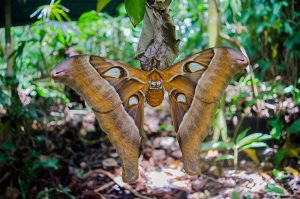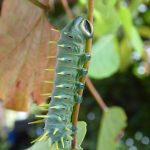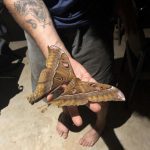Critter Corner – Hercules Moth
#CritterCorner – You may have heard of Hercules… but what about Hercules Moths (Coscinocera hercules)?
Despite being the largest moth in the world… Hercules Moths don’t eat! Why??? Because they don’t have mouths! As adult moths, they survive on food stores that they ate prior to metamorphosis.
Hercules Moths spend most of their lives (approx. 3 mths) as caterpillars.
During this time, they live on food plants such as the bleeding heart (Homalanthus novoguineensis), red bean trees (Dysoxylum mollissimum subsp. molle) and cheese trees (Glochidion ferdinandi). As caterpillars, they can grow up to 14.5cm in length and weigh up to 45g, are pale green in colour and have spots and striking yellow spikes.
Once emerged from their cocoon, these beautiful moths only live for 10 to 14 days, and their main goal is to find a mate & reproduce. As adults both males and females are brown in colour and their wings are spectacular – they have transparent triangular ‘windows’ and white triangular edges. The female is the larger of the species and they do not have long tapered tails like their male counterparts.
Fun facts:
- Females emit a pheromone so strong that the males can smell it from over 2km away (don’t worry, humans cannot smell this pheromone).
- The largest ever Hercules Moth had a wingspan of 36cm! No wonder they’re called Hercules Moths!
- The Hercules Moth is the largest moth found in Australia, and its wings have the largest documented surface area (300 square centimeters) of any living insect.
- ‘Feathered’ antennae indicate a moth with no mouthparts.
- Image courtesy of the Australian Butterfly Sanctuary
- Image courtesy of our Nursery Manager, Marine
Sources: Wet Tropics Management Authority and Australian Butterfly Sanctuary
Want more good Rainforest news in your life?
Subscribe to our eNews | Follow us on Instagram | Like us on Facebook | Subscribe to our YouTube channel
Help Protect Rainforests Forever
Donate to Protect Rainforests Forever | Become a Rainforest Guardian for as little as $2 a month | Partnership Options




